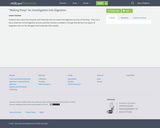
Pathogens Unit Objectives: By the end of this unit, students will be able to…- Explain the most likely method by which a pathogen gains entrance into its host.- Explain how a pathogen can become established by focusing on a specific kind of tissue.- Summarize the main causes of bodily damage from an infection by a pathogen.- Identify and categorize each of the following by the unique characteristics and identifying traits: a. Bacteria b. Viruses c. Fungi d. Protozoa e. Helminth- Define a prion and explain the characteristics that make this class of pathogens unique.- Compare and contrast prokaryotic and eukaryotic organisms.- Summarize how to classify bacteria, including by shape, aerobic/anaerobic, and by gram stain.- Compare and contrast the differences between gram negative and gram positive bacteria, particularly inregards to cell membranes and cell walls, susceptibility to antibiotics, and endotoxins vs. exotoxins.- Compare and contrast the properties of endotoxins vs. those of exotoxins.- Summarize the properties of peptidoglycan and relate how these properties affect the susceptibility ofsome bacteria to antibiotics.- Summarize the properties and characteristics of the membrane outside of the cell wall of some bacteriain regards to susceptibility to antibiotics, infection of a host, and resistance to host defenses.- Summarize how a bacterial infection can lead to the death of a host via sepsis and septic shock.- Explain why a virus is not considered to be a living species.- Summarize how viral reproduction occurs.- Compare and contrast a retrovirus to a standard virus.- Identify the kingdom of life in which fungi are classified.- Summarize the key traits of protozoa.- Explain how the symptoms diseases caused by helminths differ from many other pathogens.- Outline the method by which a prion causes a disease and identify practices that increase the likelihoodof a prion infection.- Describe the existing treatments and/or cures for a prion disease.
- Subject:
- Agriculture, Food and Natural Resources
- Material Type:
- Module
- Author:
- Jennifer Russell
- Date Added:
- 08/14/2018
